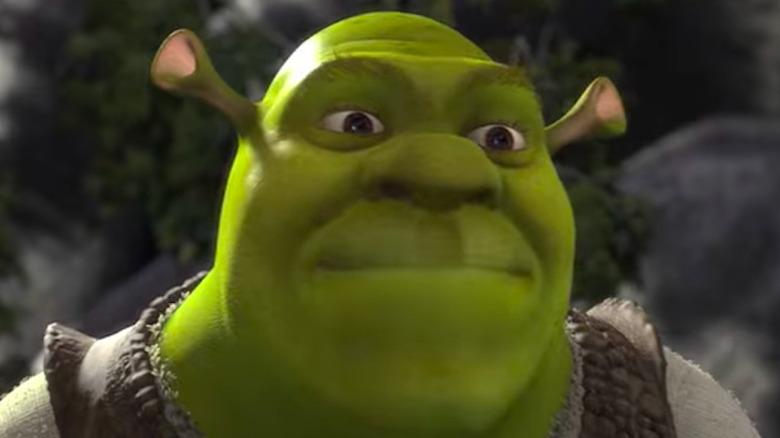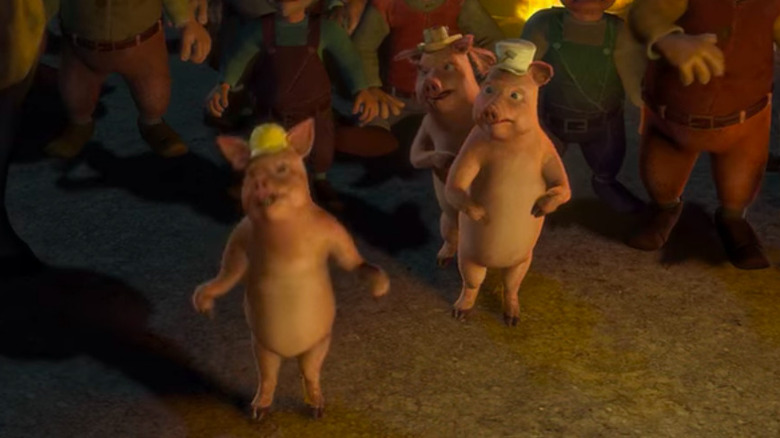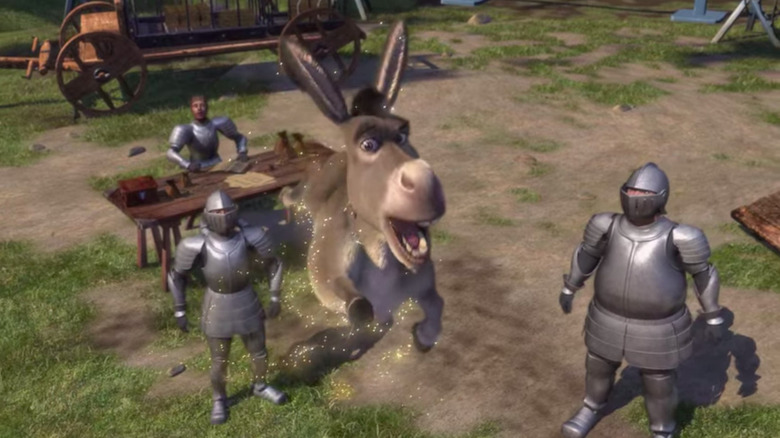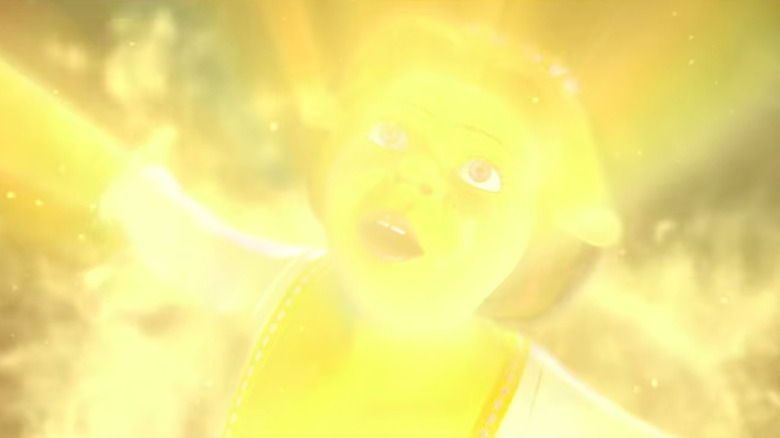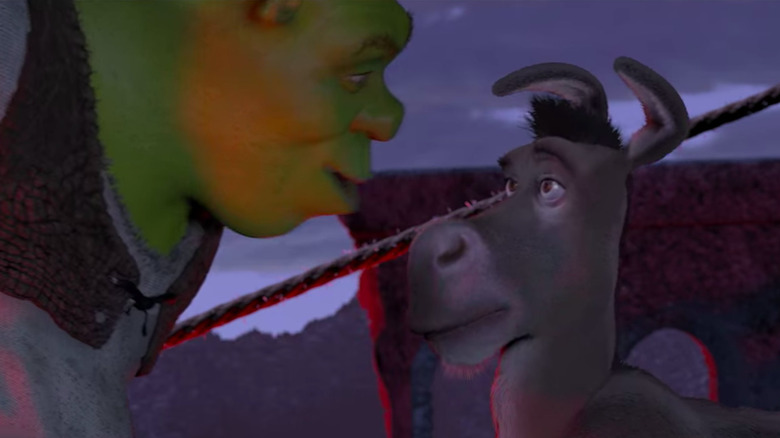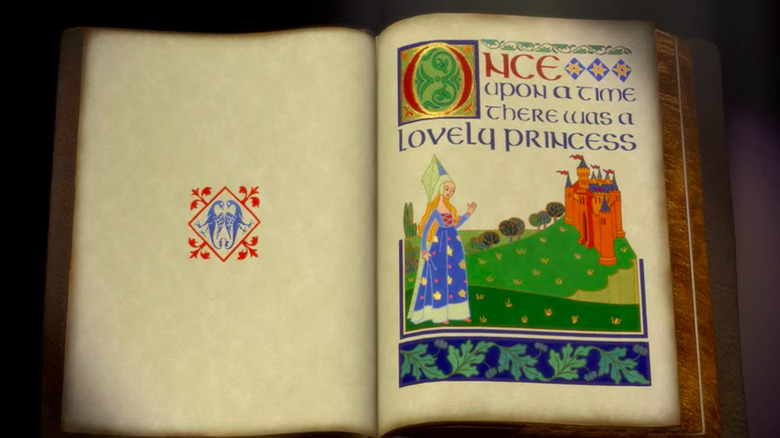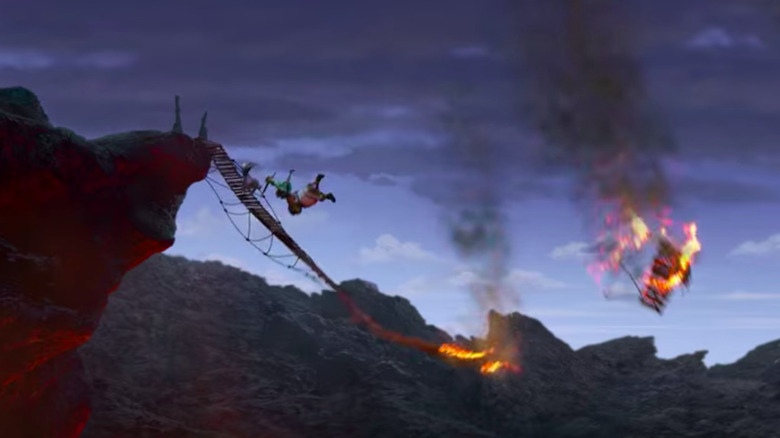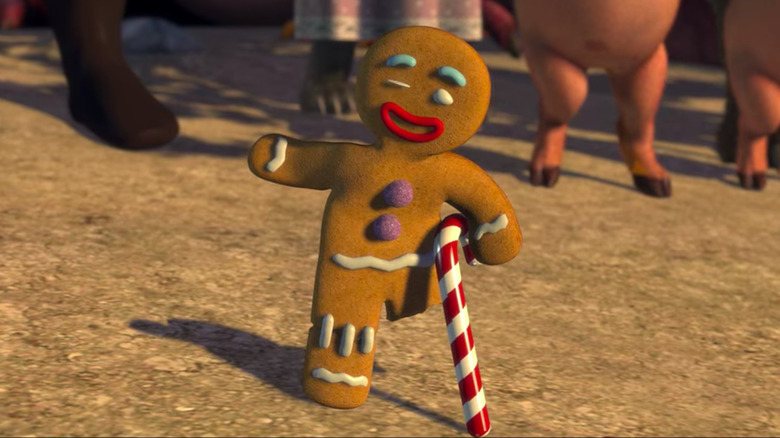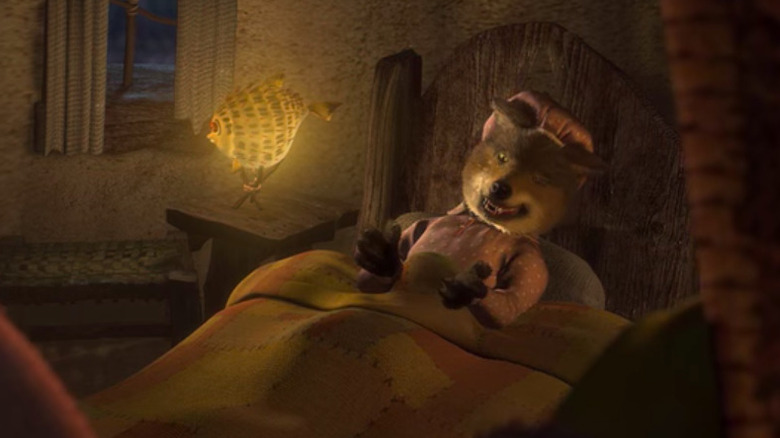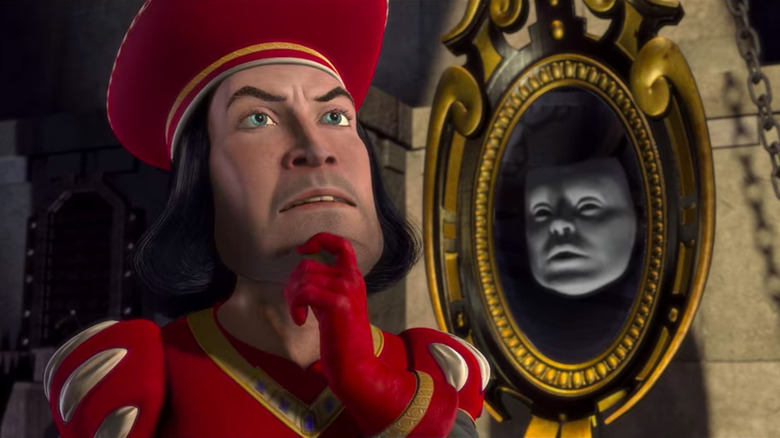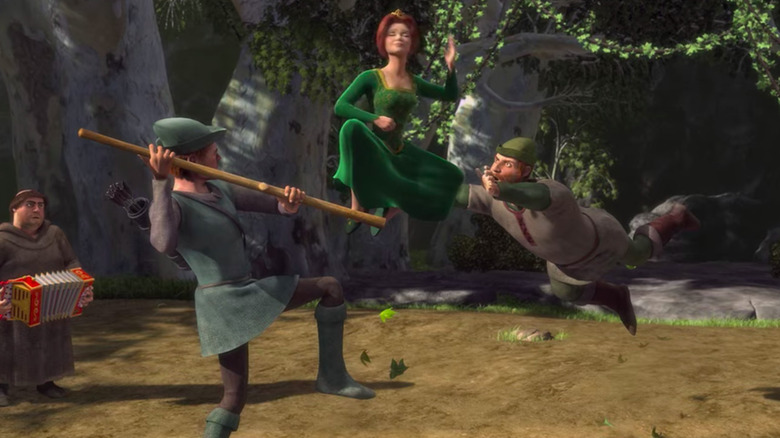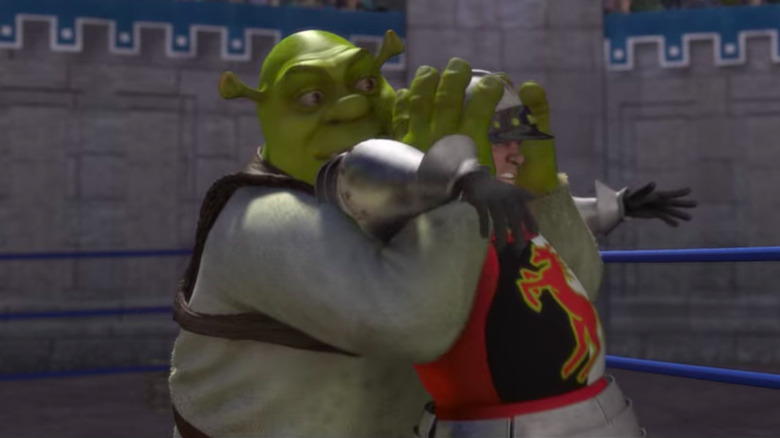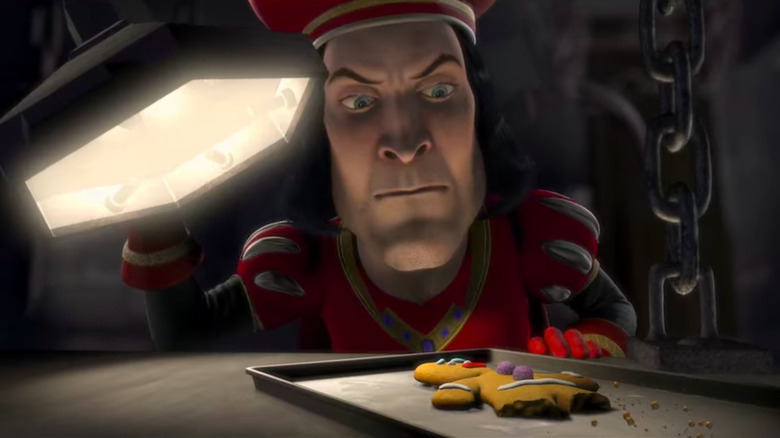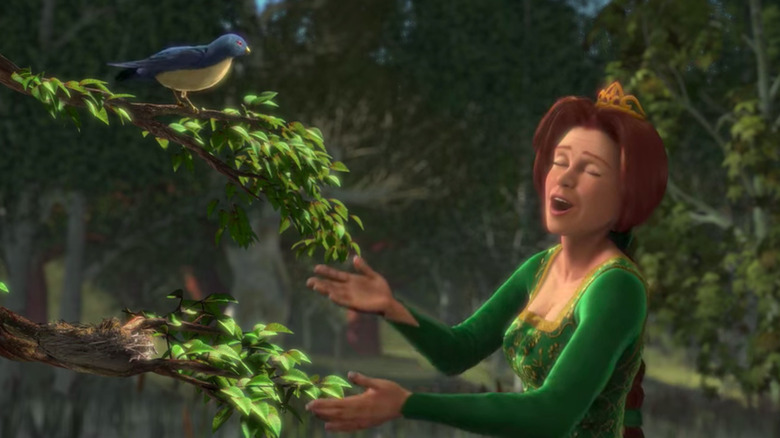The Best References In Shrek Ranked
When the first "Shrek" movie was released in 2001, it proved that animated fairy tales didn't have to adhere to the traditional Disney model. Sure, the film features a noble quest, a princess trapped in a tower, and a true love's kiss, but it also includes a heartwarming message about not judging a book by its cover. From start to finish, "Shrek" is loaded with clever subversions of traditional fairy tale tropes, many of which are direct Disney references that both celebrate and satirize the animation pioneer's beloved films.
"Shrek" was so hilarious, creative, and clever that it won the very first Oscar for Best Animated Feature, demonstrating that both critics and viewers could still embrace fairy tales, especially when presented in such an original way. However, "Shrek" wouldn't work without all the princess stories and childhood fables that came before it and their impact on pop culture. In fact, part of the fun of watching "Shrek" is in seeing how many references you can spot, even if some are more noteworthy than others. Here are the best references in "Shrek," ranked.
14. The Three Little Pigs quote their own fable
The journey of Shrek (Mike Myers) begins when Lord Farquaad (John Lithgow), the ruler of Duloc, dumps all the fairy tale creatures creating chaos in his land in the swamp where the misunderstood ogre lives. The creatures' arrival leads to a scene with a ton of references, with everyone from the three blind mice to the seven dwarfs (toting a comatose Snow White) showing up.
One of the most memorable moments in this scene nods to the well-known children's story "The Three Little Pigs." In the fable, the Big Bad Wolf blows down each of the pigs' houses, until the third pig wisely decides to make his house out of brick, which withstands the villain's assault. When those same three pigs appear in "Shrek," they explain the fairy tale creatures' presence in his swamp with the familiar line, "He huffed and he puffed and he ... signed an eviction notice."
The first part of that line is directly quoted from "The Three Little Pigs," metaphorically making Farquaad the Big Bad Wolf. As the second half of the line implies, however, Farquaad wants to get rid of the fairy tale creatures, not destroy their homes and eat them, so he signs a document to make it so. It's a funny throwback to a famous tale that also establishes the bureaucratic evil of Farquaad. Nonetheless, it doesn't reach the hilarious heights of many of the other references in the film.
13. Donkey's Peter Pan flight
In "Shrek," Lord Farquaad places bounties on fairy tale creatures, resulting in the humans who know them turning them in for cold, hard cash. When the elderly woman who owns Donkey (Eddie Murphy) attempts to give him up, however, he refuses to prove he's supernatural by talking, thereby ruining her chances of getting paid. In her frustration, she kicks a small cage out of the hands of the boy in line behind her as knights drag her away. Many "Shrek" viewers will notice that the boy resembles Peter Pan and that the cage holds a fairy who looks like Tinker Bell, who drops pixie dust on Donkey as she falls on top of him. As anyone familiar with the story of "Peter Pan" will know, pixie dust enables you to fly, which is exactly what Donkey does.
If that weren't enough, as soon Donkey takes to the air, he shouts "I can fly!" His exclamation is quickly echoed by both Peter Pan and the Three Little Pigs. The repetition of the line perfectly mimics the chorus of the song "You Can Fly" from Disney's animated version of "Peter Pan." Of course, this is "Shrek," so after the first three proclamations, the knight who just turned Donkey's owner away exclaims "He can talk!" It's a brief but amusing spin on a well-known detail from a popular fairy tale.
12. Fiona's transformation mimics Beauty and the Beast
Disney's "Beauty and the Beast" is one of the most beloved animated movies of all time, and in many ways, "Shrek" treads similar thematic territory. Both stories center on supposedly beastly characters who aren't nearly as monstrous as they initially appear. The Beast of "Beauty and the Beast" is cursed to remain in his furry form until someone falls in love with him. In a flip of that script, "Shrek" establishes that Princess Fiona (Cameron Diaz) lives as a human by day and an ogre by night. Until she kisses her true love, her form won't settle one way or the other.
Fiona assumes that when the kiss she covets occurs, she'll become human permanently, just like the Beast eventually does. When she finally kisses Shrek, the film makes the reference even more explicit by having magic move through her and lift her body off the ground, just like it does to the Beast. However, because Fiona's true love is an ogre, the "love's true form" she permanently takes is that of an ogre as well. Fortunately, Shrek's there to reassure her that she's still beautiful, further driving home the movie's message. It's a nice and clever moment, even if it doesn't pack quite the same punch as some of the film's other references.
11. Shrek references Babe to calm Donkey
Though Donkey willingly accompanies Shrek on his quest to rescue Princess Fiona, he's not exactly prepared for the challenges they encounter when they reach her. First on the list of things that terrify Donkey is, as he aptly explains it, the "rickety bridge over a boiling lake of lava" that leads to the castle. Despite his fears, Shrek manages to get Donkey to start crossing the bridge, but when one of the wooden planks breaks and falls into the lava below, Donkey panics and begs Shrek to let him flee.
The pair are already halfway across the bridge, however, so Shrek uses Donkey's fear to get him to continue moving. He distracts Donkey by making the bridge swing back and forth, all while walking toward him, forcing Donkey to back up until he finds himself safely on the other side. As Donkey realizes that the danger has passed, Shrek leans down and tells him, "That'll do, Donkey. That'll do." The quote is taken from the Oscar-winning family film "Babe," in which the title character — a pig — unexpectedly learns to herd sheep. When Babe wins a sheep-herding contest, his owner Farmer Hoggett (James Cromwell) praises him just as Shrek does Donkey. Given Donkey is also a farm animal doing something unusual, Shrek's use of the line seems appropriate.
10. The storybook intro
The storybook opening with voiceover narration is a widely used trope, especially in animation. It's a device Disney popularized in its very first feature-length animated film, "Snow White and the Seven Dwarfs," and the company used it repeatedly over the succeeding decades in films like "Cinderella," "Sleeping Beauty," "Pinocchio," and "The Jungle Book." "Shrek" starts with the very same trope, but it quickly subverts it.
The storybook opening in "Shrek" begins traditionally enough, with the eponymous Ogre narrating the story of a trapped princess waiting for her true love's kiss. After a few pages, though, Shrek interrupts himself, tears out the next page of the book, and declares the story "a load of" something, with the last word being cut off by the sound of a flushing toilet. The screen then switches to Shrek's swamp, where the green ogre emerges from an outhouse and proceeds to go about his day. Given how widely used this trope is, it's no surprise that "Shrek" employs it. The joke works in some silly potty humor while also declaring that the movie's going to be a different kind of animated fairy tale.
9. The castle escape references Indiana Jones
Most of the references in "Shrek" are taken from fairy tales, children's stories, and family films, but for the action-packed sequence where Shrek, Donkey, and Fiona escape the dragon's castle, the filmmakers decided to nod to an adventure movie instead. Shrek gets things a little out of order when he arrives to rescue Princess Fiona, retrieving her before he's slayed the dragon. This leaves him, Fiona, and Donkey with a formidable obstacle on their way out.
Shrek traps the dragon by bringing some chains down around her neck, but she can still breathe fire. As the group runs out of the castle's entrance to the bridge across the lake of lava, the dragon lets out a fearsome flame, burning half of the bridge away. As the other half plummets, Shrek, Fiona, and Donkey hang on for dear life before managing to climb to safety. The specific shots used reference a similar action-packed scene in "Indiana Jones and the Temple of Doom," where Indy (Harrison Ford) confronts a group of bad guys on a rickety bridge of his own. He uses his sword to bring the bridge down in the hopes of protecting his allies Short Round (Ke Huy Kuan) and Willie (Kate Capshaw). It's not the most obvious reference in "Shrek," but it's a fun one for those who notice it.
8. The Gingerbread Man channels Tiny Tim
In the movie's final moments, Shrek and Fiona get married in front of all the fairy tale creatures Shrek previously tried to remove from his swamp. The crowd cheers for them as they drive off in a carriage (made of an onion), and the minuscule Gingerbread Man — finally free after being tortured by the vanquished Lord Farquaad — is seen walking with a candy cane in front of the crowd. As everyone else waves goodbye, the Gingerbread Man declares, "God bless us, every one."
In both looks and words, the Gingerbread Man is channeling Tiny Tim from "A Christmas Carol." The sickly youngest son of the poor but generous Bob Cratchit, Tiny Tim uses a crutch to get around and is small for his age. However, he's also always grateful for what he has, which is shown in his generous quote. Despite the terrible injuries he endured at the hands of Farquaad, the Gingerbread Man appears similarly optimistic in this moment. His words are the last ones spoken in the film, ensuring that the movie closes with one final reference to another well-known story.
7. Little Red Riding Hood's wolf hides in Shrek's bed
When Shrek's home is invaded by fairy tale creatures early in the movie, he finds an unwanted guest in his bed: The Big Bad Wolf. The fact that he's dressed in grandmother attire means he's clearly the version of the villain from the fairy tale "Little Red Riding Hood." In that story, the wolf learns Little Red Riding Hood is going to her grandmother's house and — searching for a meal — he beats her there, eats her grandmother, and then dresses up in Granny's clothes to trick Little Red Riding Hood so he can eat her too. In several versions, Little Red Riding Hood and her grandmother are saved by a passing hunter, and the wolf is killed.
In "Shrek," however, the wolf is very much alive and well, still dressed in Granny's clothes. Moreover, he's apparently still waiting in bed for a tasty morsel to drop by. In fact, "Shrek" implies this is just what the Big Bad Wolf does to pass the time. When Shrek looks in the bedroom and sees the wolf, his response is an annoyed "Whaaat?" It's a brief but funny moment that also makes you wonder whether the wolf prevailed over Little Red Riding Hood and her grandmother in this particular universe.
6. The Magic Mirror's Dating Game
Lord Farquaad knows nothing about Princess Fiona until his soldiers find the Magic Mirror (Chris Miller), which he apparently wants so that it can tell him how perfect his kingdom is. But when the Magic Mirror points out that Farquaad isn't a king and the diminutive Lord reacts negatively to the observation, the Mirror's forced to reveal that Farquaad and Duloc can level up their royal status if Farquaad marries a princess. This leads to the Magic Mirror showing Farquaad three eligible princess bachelorettes in a sequence right out of "The Dating Game."
The long-running game show and its various iterations center on a bachelor or bachelorette asking three potential dates questions to help them choose which one to go out with. The Magic Mirror's introduction of the princesses not only uses similar music to "The Dating Game," but the brief description of each princess also mimics the introduction of the bachelorettes on the show. Farquaad's eager knights even shout the numbers of their favorite options, standing in for the audience on "The Dating Game," who also loudly championed their favorite contestants. The show has remained prominent enough in pop culture that the reference is pretty easy to catch, even today. And if you miss it, the mechanics of game shows are so well known that the scene is still amusing.
5. Fiona fights like she's in The Matrix
"Shrek" hit the big screen a mere two years after the premiere of 1999's "The Matrix," a groundbreaking sci-fi movie that changed the way big-screen fights were choreographed and filmed (per Vulture). So, of course, one of the fight sequences in "Shrek" looked to the sci-fi classic for inspiration. As Shrek, Fiona, and Donkey walk through the woods to Duloc, they're accosted by Robin Hood, who thinks he's rescuing Fiona from the supposedly scary ogre. Even though Fiona clearly has no interest in Robin Hood, he doesn't get the hint. He sings a song with his Merry Men that plays up his achievements, threatening Shrek all the while. Instead of sitting through it passively, though, Fiona takes matters into her own hands and knocks Robin Hood out.
In response, the Merry Men attempt to defend their leader and themselves, but to the complete and utter astonishment of Shrek and Donkey, Fiona easily takes them down with her own slick, bullet-time martial arts — an explicit reference to the stylized fights and camera work of "The Matrix." Fiona's ability to defend herself impresses Shrek, establishing her as far from a damsel in distress while also referencing one of the most popular movies of the era.
4. The Duloc WWE match
When Shrek goes to Duloc to demand Lord Farquaad kick out the fairy tale creatures squatting on his land, he finds a ghost town. It turns out that everybody is at a tournament staged by Farquaad to determine which of his knights he'll send to retrieve Princess Fiona. When Shrek enters the arena, however, the proceedings come to an abrupt stop, and Farquaad turns the knights who were supposed to fight each other on Shrek. The ogre ends up being more than a match for them, but he doesn't fight the way they do. Instead, he engages them in a wrestling match straight out of the WWE.
Shrek enters the ring where the knights were supposed to fight and uses the ropes to propel himself forward. The fight, set to Joan Jett's "Bad Reputation," consists of Shrek jumping off the turnbuckles, flipping onto his opponents, and body-slamming them into the ground. He and Donkey even tag-team to knock out a knight, and the whole thing gets the crowd so excited that they start to root for the interlopers. One woman even shouts for Shrek to smash a knight with a folding chair — a classic pro wrestling move. Shrek encourages the crowd's frenzied adoration until he's taken out all of Farquaad's men. It's an amusing and thrilling rendition of a WWE match in a very unexpected place, and it thoroughly shows off Shrek's considerable fighting skills.
3. The Gingerbread Man interrogation scene
Before he's ever even seen in "Shrek," Lord Farquaad's vendetta against fairy tale creatures is thoroughly established. But the true depths of his monstrosity aren't shown until he's properly introduced. In his first scene, Farquaad interrogates and tortures the Gingerbread Man for information on the location of more fairy tale folk. While the scene is extremely funny, part of the reason it works so well is that it borrows heavily from TV and film interrogation tropes.
The camera looks up at Farquaad, putting him in a position of power, while looking down on the powerless Gingerbread Man. Farquaad mocks him by quoting his own folktale ("Run, run, run as fast as you can, you can't catch me I'm the Gingerbread Man!"), further emphasizing his power. At the same time, Gingy shows his own strength by taunting his tormentor ("Eat me!") and telling him that he's a monster. This is followed by Farquaad shining a bright light in the Gingerbread Man's eyes to disorient him and force him to talk. The scene is a well-executed mixture of references from far more mature movies and well-known folk tales, but it also remains anchored in the world of "Shrek."
2. Princess Fiona's deadly singing
When we meet Fiona, she seems like a stereotypical fairy tale princess. She can get a little frustrated, especially with Shrek's antics, but overall she seems to adhere to the Disney tradition of fair animated maidens. So when Fiona wakes up the morning after Shrek rescues her and starts singing with a nearby bird, it seems fitting. After all, Snow White did something similar while warbling by a wishing well about waiting for her prince. However, Fiona's song isn't nearly as innocent as Snow White's.
As she sings with the bird, Fiona hits progressively higher and higher notes. The bird does its best to keep up with her, but when she holds a particularly high and long note, it simply can't handle it. The physical exertion causes it to explode, leaving only its featherless legs behind. It's another unexpected subversion of an established Disney fairy tale trope that's made even more surprising and memorable by its shocking (but hysterical) result. Fiona serves the bird's eggs to Shrek and Donkey for breakfast — something Snow White surely could never imagine.
1. Duloc is a parody of Disneyland
After Shrek's swamp is overrun with fairy tale creatures, he goes to Duloc to demand Lord Farquaad give him his land back. But first, the pair must traverse the city, which itself is a parody of Disney's various amusement parks.
The satire starts as soon as Shrek and Donkey enter Duloc. A sign hovering over a parking lot full of horses and carriages says that the area is called "Lancelot." Disney uses a similar naming system for its own parking areas. Then, as the two approach the town entrance, they encounter a man in a giant costume head — a reference to the various characters who greet guests throughout Disneyland and Disney World. In a fairly accurate replica of the lines for Disney's rides and entrance kiosks, the man is seen standing by a series of ropes dictating where people should form up. The setup is even complete with a nearby sign that claims that, from that point in the line, visitors still have 45 minutes to wait.
The sequence ends with one of the movie's true highlights. As Shrek and Donkey walk through the turnstiles and past meticulously designed gift shops and manicured plants, they encounter an information booth. When Donkey pulls the lever, it showcases a group of singing, dancing mechanical dolls that recite the rules of Duloc. It's a clear reference to Disney's infamous "It's a Small World" ride, complete with a catchy song that the childlike Donkey loves and Shrek can't stand.
